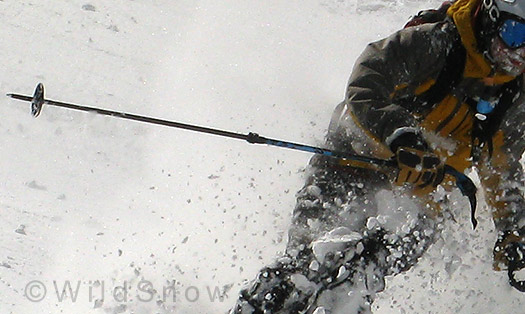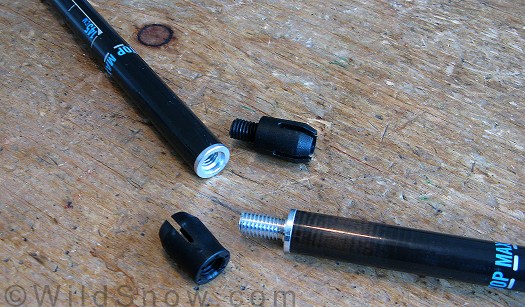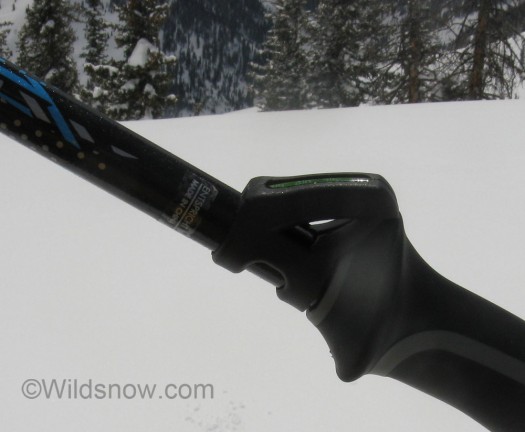
Testing k2 Lockjaw backcountry ski poles about a week ago. Yep.
I reviewed the original aluminum K2 Lockjaw ski poles last year, and they worked well. Mine are now a little beat up, and K2 has improved the poles quite a bit for the next iteration — so time for another review.
I tried out the carbon version this time around. Aluminum poles have the advantage of bending instead of breaking, while carbon poles are stronger and lighter but can splinter into sharp shards when they do break. Yep, tradeoffs. The k2 lockjaw has an aluminum upper section, with a large diameter carbon lower section. Features abound: built in inclinometer on one pole; lower sections screw together to create an avalanche probe; markings measure snow depth; super comfy straps work well for hauling yourself uphill when your legs give out.
I always carry my inclinometer/compass in my pocket when I’m touring, for easy access. An inclinometer is of course an awesome tool to use in terrain evaluation. I try to suss out slope angles as much as I can, not only to decide where to ski but also to hone my angle estimation skills.
For the previous Lockjaw model, K2 provided inclinometer marks on the poles, but they were a pain to use and not very accurate, besides, you can make the same marks on any pair of poles. This year K2 got smart and put a small “bubble” style inclinometer on one pole of the pair. It is tiny and unobtrusive, but is quick to use when you need it. The mechanism only shows angles between 30 and 45 degrees, so I’m still using the inclinometer on my compass as well. It would be great if K2 put an inclinometer on the other pole that showed lower angles, like 20 to 35 degrees.
If you’re a savvy backcountry skier, you know that it’s much easier on your shoulders and more efficient if you grab your uphill pole below the grip when doing steep traverses. The help, Lockjaw poles have a grippy coating on the upper section, similar to the grip paint on some skateboards. I don’t really like having duct tape or a bulky grip on the lower section of a pole, so this unobtrusive coating is a terrific alternative.
The carbon bottom sections screw together into a sturdy, 180 cm probe. The avalanche probe feature is nice, although I still carry a real probe. It might be nice to have a extra probe in a rescue situation, especially if you break your main one, or something like that. It’s tempting to substitute the built in probe for a real one, especially with advances in beacon technology that make the pinpoint search more accurate. I don’t know if I’ll ever do that, but some people don’t carry probes at all during days when the snow is deemed to be super stable, notably my Dad and Andrew McLean (defunct link removed 2015).

Probe conversion threads, k2 Lockjaw ski poles. Resulting probe is rigid and quite functional. The black things are rattle reducers that fit on associated threads. They could be left off for quicker conversion.
Another minor change for the new Lockjaw is the lock mechanism. It functions similar to the older but the cam lever sticks out less, making it a little more difficult to change with gloves on. Didn’t seem to be an issue, but I thought I’d mention it. In fact, the slightly sleeker design might be an advantage as it’s less likely to snag on clothing or pack straps.
In all, a truly dedicated ski pole for the backcountry that’s more fully featured than any other we know about. Impressive, especially the the built-in inclinometer.
Louie Dawson earned his Bachelor Degree in Industrial Design from Western Washington University in 2014. When he’s not skiing Mount Baker or somewhere equally as snowy, he’s thinking about new products to make ski mountaineering more fun and safe.


